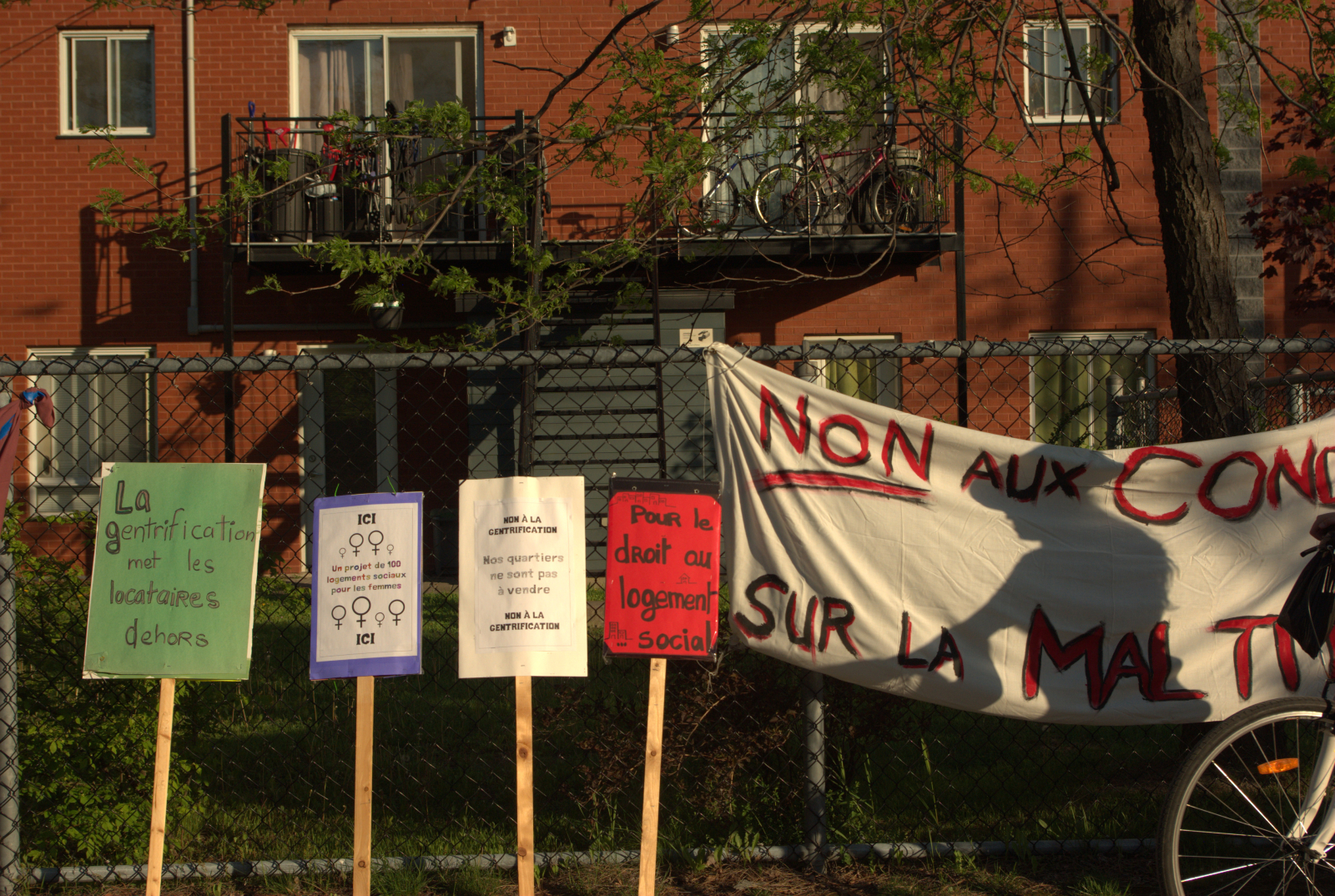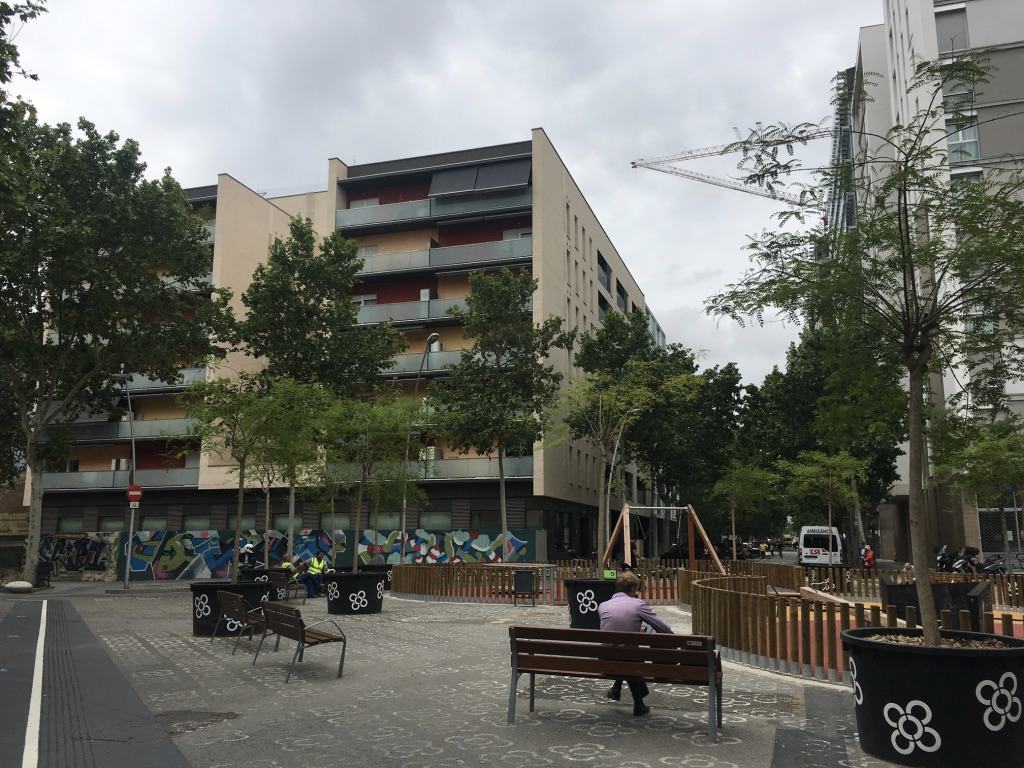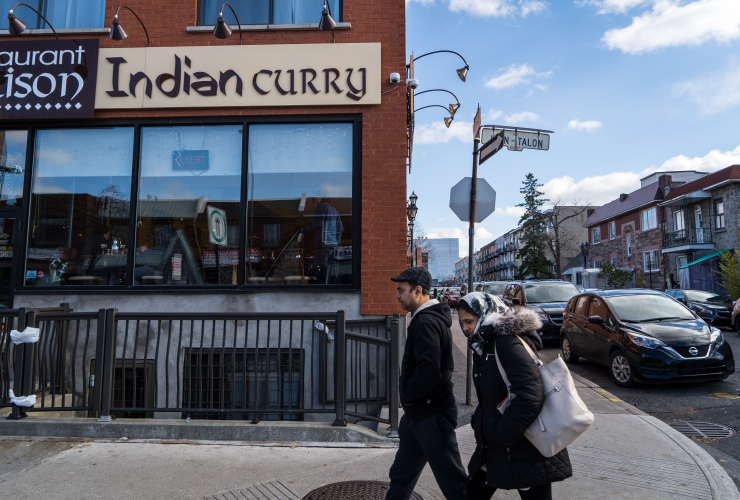What was once an island of asphalt now boasts 7,000 square metres of greenery and more than 2,000 trees and shrubs.
The St-Pierre Woonerf is a wide street that runs for half a kilometre through the west end of St-Henri, a former industrial district that hugs the Lachine Canal in southwest Montreal.
Woonerf is Dutch for “living yard.” It’s a street where paths for pedestrians and cyclists and amenities like playgrounds, benches and trees dominate infrastructure for vehicles. First created in the Netherlands in the 1960s in reaction to car-centric streets popular after the Second World War, woonerfs are now popular across Europe and North America.
The St-Pierre Woonerf is hailed as the “pride of the borough” by Benoit Dorais, Montreal city councillor and borough mayor of the Sud-Ouest. It has won multiple sustainable development awards since opening in 2013.
But there’s a less refreshing consequence of the woonerf, say community housing activists. They assert that it has been a “motor for gentrification” in an already gentrifying neighbourhood.
Property prices have escalated in St-Henri since the early 2000s. Median monthly rent jumped by 19.8 per cent from 2011 to 2016 (compared to 12.4 per cent in Montreal), according to a figures provided to National Observer by Quebec housing advocacy group FRAPRU.
Median rent in St-Henri rose from $657 in 2011 to $787 five years later. In Montreal in 2016, it was $777 per household.
Fred Burrill is a long-time St-Henri resident who is researching the history and gentrification of the neighbourhood at Concordia University. He told National Observer that the woonerf is an example of how “greening development paid for with public money becomes a motor for speculation on the private market.” In this case, he said, “the borough government invested massively to turn this into green space, but immediately after it became a massive condo development called Alcôve on the Woonerf."
The woonerf cost the Sud-Ouest borough $1.193 million and the province $707,000.
"Gentrification in the west of St-Henri has come much later [than in the east]. But in the last years, especially in the streets around [the woonerf], it is getting very, very gentrified. We see a lot of demolition of older buildings, construction of condos," Olivier Prud'homme-Richard from local housing group POPIR told National Observer. "Having a beautiful street where people can walk definitely has an impact – its attractive to condos."
In a door-to-door survey in early 2018, POPIR found that 45 per cent of the households on St-Marie Street, which flanks the St-Pierre Woonerf, had lived there for less than a year. "Gentrification is displacement," said Prud'homme-Richard. "I don't see the point of having a green project if the new project will just displace poor people on a long-term basis."
Both Prud'homme-Richard and Burrill said that greening projects like the woonerf should be coupled with investments in social housing (housing that is subsidized for low-income residents). “Any urban greening project that is not also engaged in an effort to collectivize the housing market in some way or another, to create non-market housing solutions, is doomed to reproduce the exact same dynamic,” said Burrill.
When questioned about the woonerf's impact on gentrification, Laurence Houde-Roy, spokesperson for the executive committee of the City of Montreal, told National Observer in an email that the "green investments that we make for our neighbourhoods have many more advantages for our citizens than inconveniences." Green projects are priorities for the government and will not be stopped, she said. They "ensure the well-being, safety and tranquility of all residents, regardless of their economic situation."
The government's strategy to reduce the negative effects of gentrification across Montreal involves encouraging the mixed development of neighbourhoods, buying land to develop social housing, and “investing efforts” to prevent insalubrious housing conditions, Houde-Roy said.
The city declined to provide further details about how it's integrating its efforts to promote more affordable housing with its efforts to pursue green projects.
Property prices have risen in St-Henri ever since the Lachine Canal, an abandoned industrial passage, was restored and reopened as a park and heritage site in 2002. A Centraide study in 2014 noted that "as gentrification has sped up [in St-Henri], underprivileged populations are constantly moving into ghettoized areas in the west end, where there is decreased access to services and a lack of food services."

Green gentrification
The process that Prud'homme-Richard and Burrill describe is known as green gentrification, eco gentrification or environmental gentrification.
Urban greening projects – like elevated walkways, parks, urban forests and cycle paths – are growing as cities respond to climate change and urban economies rely less on traditional industry and more on attracting skilled workers to advanced service and knowledge industries. The greening projects sometimes have the consequence, often unintended, of hiking nearby property values and the cost of local services, and displacing lower-income residents.
A famous case of green gentrification is New York’s High Line on Manhattan’s Lower West Side, which opened in 2009. Once a disused elevated railway line, it is one of New York’s most visited tourist attractions, an elevated walkway resplendent with more than 100,000 plants, trees and shrubs. Property prices around the railway line more than doubled between 2003 and 2011, and research has shown that the High Line services an "overwhelmingly white" crowd that is unrepresentative of local communities. High Line co-founder Richard Hammond issued a mea culpa for his project in 2017, telling CityLab: “We were from the community. We wanted to do it for the neighbourhood. Ultimately, we failed.”
In December, a National Observer article that mentioned the potential for green gentrification in Park-Extension, another Montreal neighbourhood, spurred lively online debate on the Facebook page of borough mayor Giuliana Fumagalli. Noting that the National Observer article she had shared a couple days prior had "caused a surprising amount of debate," she asked her constituents in another post whether they felt eco-gentrification existed in Montreal.
Isabelle Anguelovski researches green gentrification at the Barcelona Laboratory for Urban Environmental Justice and Sustainability. She told National Observer that while the academic field dates to the mid-2000s, the dynamics are not new. In the mid 19th century, 1,600 people, mostly Irish and African American, were evicted from their homes to clear space for New York’s Central Park. But more recently cities started to “brand themselves” as sustainable by bringing nature back into the city “in a more visible way,” she explained.
Vancouver is a city that has led that charge. Routinely voted one of the most sustainable cities in the world, it has a bold plan to become the greenest global city, which includes ensuring all Vancouver residents live within five minutes of a park, greenway or other green space by 2020. Portland, Seattle and San Francisco are other examples of cities with large-scale green projects essential to their “urban branding,” Anguelovski said.
The Barcelona Laboratory collaborates with the Barcelona city government on research that looks at an ambitious urban development project intended to maximize car-free space in the Spanish city. Barcelona aims to transform 503 nine-square-block sections of the city grid into “superblocks.” Major traffic will be diverted around these blocks and traffic within will be limited to 10 kilometres an hour. The hope is to increase public space and cut the city’s traffic, air-pollution, and noise levels.
The first superblock opened in the post-industrial district of Poblenou more than two years ago. Though hard to measure at this early stage, Anguelovski said the superblock along with other new green amenities has led to a "rebranding" of the area and a real estate price hike. A second superblock has accelerated gentrification in the “already-gentrifying” neighbourhood of Sant Antoni, she said.
As more superblocks are launched, the Barcelona Laboratory will offer advice to the city on ways to retain affordability in the local neighbourhoods. “The city is very conscious about [gentrification] and is trying to do as much to preserve the commercial and retail fabric of each neighbourhood,” said Anguelovski. Options include acquiring empty parcels of land and empty buildings for public and social housing, and introducing a moratorium on new cafes and restaurants.
Social and affordable housing is key to prevent green gentrification, Anguelovski said, noting that cities least affected by its dynamics, such as Berlin and Vienna, are those where there is stringent rent control and large quantities of publicly-supported housing for rent and for sale.
She said the Laboratory is also hopeful that the network of superblocks will ultimately prove a hypothesis that smaller greening projects scattered across a city have a less acute impact on housing prices and community displacement than flashy, one-off projects like the High Line.

Parks, cafes and riverwalk
“There are versions of green that are not about luxury development, riverfront walks and LEED-certified condo buildings,” gentrification researcher Winifred Curran from DePaul University in Chicago told National Observer.
In Newtown Creek in Brooklyn and Queens, a coalition of community groups achieved “substantive environmental remediation” of a polluted tidal estuary, she explained. The clean-up opened green spaces in areas that remained zoned for manufacturing, thus protected existing businesses and jobs. It did not spur high-end residential and commercial development, or what Curran calls the “parks, cafes and a river walk model.”
While encouraged by the example, Curran said city and real estate developers should execute policies to prevent eco-gentrification and displacement from the onset of a project. “Cities and developers actually have the resources to do this work, as opposed to community groups who often don't,” she said. While private and public developers in the United States are increasingly aware of the risks of eco-gentrification, she said “unfortunately, the onus is still put on community groups to argue for alternative visions on how to get this stuff done.”
'On the radar'
David Miller is former mayor of Toronto and ambassador for inclusive climate action for the C-40 Cities Climate Leadership Group (C-40), a network of 96 cities, among them Vancouver, Montreal and Toronto, working to deliver urban solutions to climate change. He told National Observer that fighting gentrification after an urban green intervention involves measures that safeguard the affordability of housing for people with a range of incomes and services that lower-income residents have historically relied on. While there has been good progress on some projects, he said, "in particular on the affordability of housing front, systematically nobody has found a great solution yet, and it is becoming more and more of a challenge."
An ongoing C-40 project is aimed at helping city mayors deliver inclusive, or socially equitable, climate action.
“[The issue of] cities becoming less affordable as they take positive steps on climate and the environment, whether that is via transportation projects or greening of infrastructure or other measures, it’s really challenging. It’s very much on the radar of the mayors and they see it as connected to the affordability of housing,” Miller explained. “We are further ahead in other equity solutions on climate than on the issue of keeping cities affordable as they become progressively more desirable places to live.”
While the issue is “recognized and there's movement” it needs “to be addressed at a global scale and will probably require the help of state governments and national governments [on top of the ways that] housing challenges have often been met," he said.
One project Miller cited as a success was the revitalization of Regent Park in downtown Toronto, an ongoing development project started in the mid-2000s. It is transforming Canada's first affordable housing complex – built after the Second World War for returning soldiers – into a mixed-income, mixed-use neighbourhood with parks, open spaces, community facilities, condos and affordable and social housing. Community members were consulted ahead of the project. They requested that affordable housing was built as well as social housing so that they could continue to live in the neighbourhood if they jumped income brackets and were no longer eligible for social housing.
Affordable housing is as important as social housing when it comes to fighting green gentrification, Miller said, because "it’s not just the very lowest income people that are pushed out by gentrification."
Montreal and Toronto were in a consortium of 31 global cities that signed a pledge at the Global Climate Action Summit in San Francisco in September 2018 to deliver inclusive climate action that benefits citizens equitably.
Green space for whom?
Houde-Roy, the City of Montreal spokeswoman, told National Observer that the city administration “recognize[s] the phenomenon of gentrification causes situations for people in affected neighborhoods. That is why housing is a priority for our administration. By implementing tools to encourage the mixed development of our neighborhoods and living environments, by buying land to develop social housing and by investing our efforts in fighting against unhealthy housing, we are working to counter the negative impacts of gentrification in our neighborhoods.”
The municipal government has pledged to build 12,000 affordable housing and social housing units across Montreal before the end of its mandate in 2021. That includes 1,250 social housing units a year for the next three years, according to Mayor Valérie Plante.
In St-Henri, 56 social housing units have been built since 2009, the year before the woonerf’s inception, according to POPIR figures provided to National Observer. Meanwhile, the housing group estimates that over 2,000 condo units were built in the neighbourhood in the period between 2005 and 2011.
Houde-Roy said the City of Montreal “attaches great importance to the development of green facilities, such as bike paths, parks, green spaces, pedestrian or green streets for all Montrealers. We will not put a stop to these projects. On the contrary, they are part of the priorities of our administration."
Gentrification researcher Burrill would like to see more from city planners. “If your plan for improving the quality of life in a neighbourhood doesn't include some way to ensure that doesn't include displacement of people who are currently there, then it’s actually not improving the quality of life,” he said.
“People who care about green space need to think more complexly about environmental justice, in a way that goes beyond the surface questions about access to green space. The question of not just making things better in a neighbourhood, but making them better for whom?”
Market driven economics will
Market driven economics will always create stratification - until those at the top of the pyramid are forced, through self interest perhaps, to pay their fair share of taxes in order to create, for themselves, their own health and safety, if for no other reason; so that others may have liveable, sustainable, affordable housing that reduces crime and desperation,
There is absolutely no reason to continue this ugly narrative that the poor, the sick, and the marginalized will inevitably destroy whatever they have. Given half a chance they are as capable as anyone, perhaps more so, in creating vibrant neighbourhoods. Sometimes they can do it without even half a chance. More shame to the egotistic elites who can never be satisfied with "enough".
Clearly we cannot proceed
Clearly we cannot proceed with projects of this nature without working in concert with non-market low housing solutions. Unfortunately, cities, even large ones, do not always have the funds to make social housing happen. Provincial, state and national governments have to reengage in a major way to provide funding and leadership in this area. The private sector is in the business of making profit and governments' job is to provide service to it's citizens - the ultimate service industry to put it in business terminology. Planning has to limit commercial activity to clearly defined squares but also provide enough variety of food, clothing and other necessities of life to mitigate the massive transportation problems and ugly malls that suburban development unleashed in the fifties and sixties. We can't complain about greening our spaces but at the same time we must make them inclusive spaces to live and work.




Comments